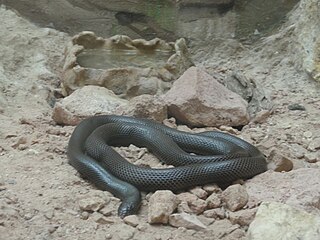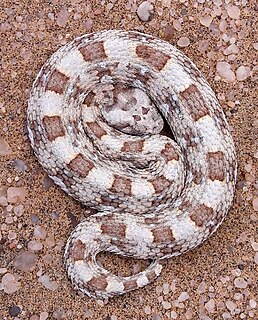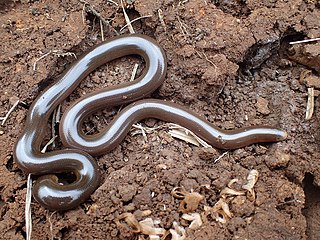
Atractaspis is a genus of venomous snakes in the family Lamprophiidae. The genus is endemic to Africa and the Middle East. The genus contains 15 species that are recognized by ITIS. Others recognize as many as 21 species. 23 are listed here.

The eastern green mamba is a highly venomous snake species of the mamba genus Dendroaspis native to the coastal regions of southern East Africa. Described by Scottish surgeon and zoologist Andrew Smith in 1849, it has a slender build with a bright green back and green-yellow ventral scales. Adult females average around 2 metres in length, and males are slightly smaller.
Uropeltis broughami, commonly known as Brougham's earth snake or the Sirumallay uropeltis, is a species of snake in the family Uropeltidae. The species is endemic to India.

Echis is a genus of venomous vipers found in the dry regions of Africa, the Middle East, India, Sri Lanka and Pakistan. They have a characteristic threat display, rubbing sections of their body together to produce a "sizzling" warning sound. The name Echis is the Latin transliteration of the Greek word for "viper" (ἔχις). Their common name is "saw-scaled vipers" and they include some of the species responsible for causing the most snakebite cases and deaths in the world. Twelve species are currently recognized.
The dwarf beaked snake, also called the western beaked snake, is a species of snake, which is endemic to southern Africa. It is in the monotypic genus Dipsina.

The berg adder is a small, venomous viper species endemic to mountainous regions in southern Africa. No subspecies are currently recognized.

The horned adder is a venomous viper species. It is found in the arid region of southwest Africa, in Angola, Botswana, Namibia; South Africa, and Zimbabwe. It is easily distinguished by the presence of a single, large horn-like scale over each eye. No subspecies are currently recognized.

Bitis inornata is a venomous viper species found only in Cape Province, South Africa. No subspecies are currently recognized.

The rinkhals is a species of venomous elapid found in parts of southern Africa. It is not a true cobra in that it does not belong to the genus Naja, but instead belongs to the monotypic genus Hemachatus. While rinkhals bear a great resemblance to true cobras they also possess some remarkable differences from these, resulting in their placement outside the genus Naja.

The Cape wolf snake is a species of oviparous, nonvenomous snake which occurs over a wide area of Southern, Central, and East Africa. Though docile and harmless, it may be confused with the very venomous stiletto snake.
Leptotyphlops distanti, also known as Distant's threadsnake or Distant's worm snake, is a species of snake in the family Leptotyphlopidae. The species, Leptotyphlops distanti, is endemic to Southern Africa.

Bibron's blind snake is a species of snake in the family Typhlopidae. The species is native to southern Africa.

The Cape file snake is a species of large, non-venomous snake endemic to Africa, belonging to the family Lamprophiidae.

The serrated hinged terrapin is a species of turtle in the family Pelomedusidae. The species is native to East Africa and Southern Africa. There are two recognised subspecies.

Aspidelaps lubricus, commonly known as the Cape coral snake or the Cape coral cobra, is a species of venomous snake in the family Elapidae. The species is endemic to southern Africa.

Wahlberg's velvet gecko is a species of large gecko, a lizard in the family Gekkonidae. The species occurs exclusively in Southern Africa.
Monopeltis capensis, also known commonly as the Cape spade-snouted worm lizard, the Cape wedge-snouted worm lizard, the Cape worm lizard, and the South African shield-snouted amphisbaenian, is a species of amphisbaenian in the family Amphisbaenidae. The species is native to southern Africa.
Pedioplanis laticeps, known commonly as the Cape sand lizard or the Karoo sand lizard, is a species of lizard in the family Lacertidae. The species is endemic to Southern Africa.

Panaspis wahlbergii, also known commonly as the Angolan snake-eyed skink, the savannah lidless skink, and Wahlberg's snake-eyed skink, is a species of lizard in the family Scincidae. The species is widely distributed in Sub-Saharan Africa. However, it likely represents more than one species.
Elapsoidea sundevallii, also known commonly as Sundevall's garter snake, is a species of venomous snake in the family Elapidae. The species is native to Southern Africa. There are five recognised subspecies.














